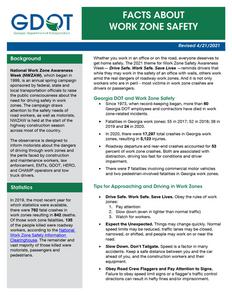National Work Zone Awareness Week (NWZAW), which began in 1999, is an annual spring campaign sponsored by federal, state and local transportation officials to raise the public consciousness about the need for driving safely in work zones. The campaign draws attention to the safety needs of road workers, as well as motorists. NWZAW is held at the start of the highway construction season across most of the country.
The observance is designed to inform motorists about the dangers of driving through work zones and the perils faced by construction and maintenance workers, law enforcement, EMTs, GDOT, HERO, and CHAMP operators and tow truck drivers.
Whether you work in an office or on the road, everyone deserves to get home safely. The 2021 theme for Work Zone Safety Awareness Week-- Drive Safe. Work Safe. Save Lives --reminds drivers that while they may work in the safety of an office with walls, others work amid the real dangers of roadway work zones. And it is not only workers who are in peril - most victims in work zone crashes are drivers or passengers.
Since 1973, when record-keeping began, more than 60 Georgia DOT employees and contractors have died in work zone-related incidents.
Fatalities in Georgia work zones: 55 in 2017; 52 in 2018; 38 in
2019 and 24 in 2020.
In 2020, there were 17,297 total crashes in Georgia work zones, resulting in 5,123 injuries.
Roadway departure and rear-end crashes accounted for 53 percent of work zone crashes. Both are associated with distraction, driving too fast for conditions and driver impairment.
There were 7 fatalities involving commercial motor vehicles and two pedestrian-involved fatalities in Georgia work zones.
In 2019, the most recent year for which statistics were available, there were 762 fatal crashes in work zones resulting in 842 deaths. Of those work zone fatalities, 135 of the people killed were roadway workers, according to the National Work Zone Safety Information Clearinghouse. The remainder and vast majority of those killed were motorists, passengers and pedestrians.
Drive Safe. Work Safe. Save Lives. Obey the rules of work zones: 1. Pay attention 2. Slow down (even in lighter than normal traffic) 3. Watch for workers.
Expect the Unexpected. Things may change quickly. Normal speed limits may be reduced, traffic lanes may be closed, narrowed, or shifted, and people may work on or near the road.
Slow Down. Don't Tailgate. Speed is a factor in many accidents. Keep a safe distance between you and the car ahead of you, and the construction workers and their equipment.
Obey Road Crew Flaggers and Pay Attention to Signs. Failure to obey speed limit signs or a flagger's traffic control directions can result in hefty fines and/or imprisonment.
For more information about work zone safety, to download the poster and to view GDOT's video please visit www.dot.ga.gov/wzs
Remember Spouses, Significant others, dads, moms, sons, daughters, brothers and sisters work here! Drive like you work here, too.
Stay Alert and Minimize Distractions. Pay full attention to the roadway and avoid changing radio stations or using cell phones and other electronic devices.
Keep Up with Traffic Flow. Do not slow down to gawk at road work.
Know Before You Go. Expect delays, leave early and schedule enough time to drive safely. For 24/7 real-time traffic information, call 511 or visit www.511ga.org before you get into the car. And follow Georgia DOT on Twitter for additional updates.
Be Patient, Stay Calm. Crews are working to improve the road and to make your future drive better.
Wear Your Seatbelt. It is your best defense in a crash. And make sure your passengers are buckled up.
WORK ZONE SAFETY AND GEORGIA DRIVING LAWS Distracted driving is a key cause of many crashes, and this especially applies in work zones. In addition to DUI and impaired driving laws, Georgia driving laws include:
Drivers, put down the phone. Georgia's Hands-Free Law requires hands-free technology when drivers use cell phones and other electronic devices. Drivers may not hold a phone in their hand or use their body to support a phone.
Move over for stopped emergency vehicles. Georgia's MoveOver Law requires drivers to move over one lane if possible when approaching stationary highway maintenance and construction workers, HERO and CHAMP operators, law enforcement or emergency vehicles, firefighters, paramedics, tow truck operators and utility service vehicles flashing emergency lights. If it unsafe to move over, slow down below the posted speed and be prepared to stop.
Buckle up. While Georgia law currently requires that front seat passengers wear a safety belt (lawmakers are considering changing the law to universal use), GDOT recommends that all occupants buckle up. In a crash, an unrestrained passenger can injure or kill another occupant.
For details on Georgia's driving laws visit https://www.gahighwaysafety.org/highway-safety/.
